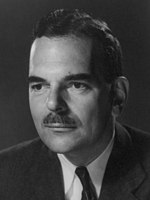| ||||||||||||||||||||||||||
| ||||||||||||||||||||||||||
 County results
| ||||||||||||||||||||||||||
| ||||||||||||||||||||||||||
| Elections in Alabama |
|---|
 |
|
|
The 1944 United States presidential election in Alabama took place on November 7, 1944, as part of the 1944 United States presidential election. Alabama voters chose eleven representatives, or electors, to the Electoral College, who voted for president and vice president.
In Alabama, voters voted for electors individually instead of as a slate, as in the other states.
Since the 1890s, Alabama had been effectively a one-party state ruled by the Democratic Party. Disenfranchisement of almost all African-Americans and a large proportion of poor whites via poll taxes, literacy tests[1] and informal harassment had essentially eliminated opposition parties outside of Unionist Winston County and a few nearby northern hill counties that had been Populist strongholds.[2] The only competitive statewide elections became Democratic Party primaries limited by law to white voters until the landmark court case of Smith v. Allwright, following which Alabama introduced the Boswell Amendment — ruled unconstitutional in Davis v. Schnell in 1949,[3] although substantial increases in black voter registration would not occur until after the late 1960s Voting Rights Act.
Unlike other Deep South states, soon after black disenfranchisement Alabama’s remaining white Republicans made rapid efforts to expel blacks from the state Republican Party,[4] and under Oscar D. Street, who ironically was appointed state party boss as part of the pro-Taft “black and tan” faction in 1912,[5] the state GOP would permanently turn “lily-white”, with the last black delegates at any Republican National Convention serving in 1920.[4] With two exceptions the Republicans were unable to gain from their hard lily-white policy. The first was when they exceeded forty percent in the 1920 House of Representatives races for the 4th, 7th and 10th congressional districts,[6] and the second was the 1928 presidential election when Senator James Thomas Heflin embarked on a nationwide speaking tour, partially funded by the Ku Klux Klan, against Roman Catholic Democratic nominee Al Smith and supported Republican Herbert Hoover,[7] who went on to lose the state by only seven thousand votes.
By 1940, there was significant opposition amongst Alabama’s planter and industrial elite to the New Deal, and there were already attempts to organise the “independent elector” movements that would proliferate after Harry S. Truman’s civil rights proposals,[8] whilst other “big mules” already supported voting Republican for President.[9] However, the hatred of the Republican label, in spite of six election cycles as a party exclusive of blacks,[10] prevented such a revolt amongst the actual electorate.[11]
- ^ Perman, Michael (2001). Struggle for Mastery: Disfranchisement in the South, 1888–1908. Chapel Hill, NC: University of North Carolina Press. p. Introduction. ISBN 9780807849095.
- ^ Webb, Samuel L. "From Independents to Populists to Progressive Republicans: The Case of Chilton County, Alabama, 1880-1920". The Journal of Southern History. 59 (4): 707–736.
- ^ Stanley, Harold Watkins (1987). Voter mobilization and the politics of race: the South and universal suffrage, 1952-1984. p. 100. ISBN 0275926737.
- ^ a b Heersink, Boris; Jenkins, Jeffery A. (2020). Republican Party Politics and the American South, 1865-1968. pp. 251–253. ISBN 9781107158436.
- ^ Casdorph, Paul D. (1981). Republicans, Negroes, and Progressives in the South, 1912-1916. The University of Alabama Press. pp. 70, 94–95. ISBN 0817300481.
- ^ Phillips, Kevin P. (1969). The Emerging Republican Majority. p. 255. ISBN 0870000586.
- ^ Chiles, Robert (2018). The Revolution of ‘28: Al Smith, American Progressivism, and the Coming of the New Deal. Cornell University Press. p. 115. ISBN 9781501705502.
- ^ Feldman, Glenn (2013). The Irony of the Solid South: Democrats, Republicans, and Race, 1865–1944. University of Alabama Press. p. 150. ISBN 9780817317935.
- ^ Feldman, Glenn (2015). The Great Melding: War, the Dixiecrat Rebellion, and the Southern Model for America's New Conservatism. University of Alabama Press. p. 60. ISBN 9780817318666.
- ^ Heersink; Jenkins. Republican Party Politics and the American South, pp. 48–50
- ^ Feldman. The Irony of the Solid South, pp. 151-152
© MMXXIII Rich X Search. We shall prevail. All rights reserved. Rich X Search


